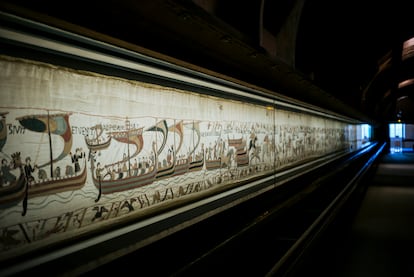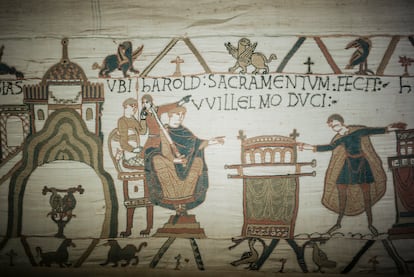The mysteries of the great medieval story of the Bayeux Tapestry
During his recent visit to the United Kingdom, French President Emmanuel Macron appeared with British Prime Minister Keir Starmer in the central hall of the British Museum to announce that an extraordinary medieval textile, the Bayeux Tapestry, would be temporarily displayed there starting in September 2026 thanks to the generous loan from the French state of a piece that had never left its territory since its earliest records. The symbolic and memorial capacity of an object from almost a thousand years ago was evoked in speeches that appealed to the shared legacy of France and England and to the Normandy landings just a few kilometers from the city of Bayeux that saved the tapestry from the Nazis.
Its borrowing has sparked reluctance from those who believe it glorifies an aggressive conquest, the only lasting invasion of the island, which marked an irreversible change in its identity and imposed the language of the new ruling class, Anglo-Norman, over Old English. Added to this is the controversy over the state of preservation of an extremely fragile and priceless fabric.
Many of these sumptuous and ornamental textiles, most of which adorned the walls of churches and palaces, have not been preserved. There are written records, but as is often the case in the Middle Ages, they hardly correspond with the preserved material record. The long and traveled social life of these objects has, however, left a trail scattered in museums and institutions around the world. About thirty early medieval textiles have been preserved, made in Britain and Ireland, probably commissioned or woven by Anglo-Saxon noblewomen. Some referred to momentous events and their participants. The Liber Eliensis, written in the 12th century, confirms the existence of a tapestry commissioned by the widow of a nobleman killed at the Battle of Maldon in 991 to commemorate his exploits against the Vikings. Women were involved in the production of these tapestries and were the ones who embroidered them, "because the woman who embroiders makes even more profit than queens," according to an Irish court ruling on the value of a needle given as collateral in a lawsuit.

The so-called Bayeux Tapestry is a singular example of the power of commemoration in the Middle Ages, of the conjunction of the relevance of a specific moment, the desire to keep its memory alive, and a certain amount of chance that, on rare occasions, allows the fixation of a founding event. On a linen weave almost 70 meters long, half a meter high, and weighing 350 kilos, embroidered with woolen threads of different colors and thicknesses, unfolds the most impressive visual account of the traumatic arrival of the Norman dynasty in England . It represents the vision of the victors, that of William the Conqueror—natural son of Duke Robert of Normandy—and his triumph at the pitched Battle of Hastings in October 1066.
This is the most splendid and largest textile to survive from the middle centuries of the Middle Ages. The originality of its narrative structure has prompted much writing. Speculation about its provenance—one side of the English Channel or the other—its commission—was it by Archbishop Odo of Bayeux, William's half-brother, to hang in the cathedral after its consecration in 1077? Was it Queen Matilda, who, according to legend, embroidered it awaiting news of battle?—and the creation of a delicate object that required technical expertise beyond everyone's reach, still spark debate among specialists.
The reality is that there is no trace of the tapestry until an inventory of the Bayeux Cathedral treasure dated 1476, more than 400 years after Hastings. If we were to guess, perhaps Abbot Baudri de Bourgeuil referred to it in a poem he composed in 1130 in honor of Countess Adele of Blois, one of William the Conqueror's daughters, whose chambers he described. The ceiling was decorated with stars, planets, and signs of the zodiac, and the walls were decorated with four tapestries. Two of them depicted biblical passages; another, scenes from Greek mythology. The fourth, his father's victory at Hastings.

It is this victory, the Norman invasion of England and the lasting establishment of a continental dynasty, that is depicted in the Bayeux Tapestry. The story begins when the elderly Anglo-Saxon king Edward the Confessor, at the end of his life and childless, sends one of his nobles, Harold, to France to offer the English crown to William of Normandy. Despite the oath of allegiance to William—which is key to the legitimacy of the new dynasty and is absent from contemporary English chronicles—Harold is crowned King of England upon Edward's death in January 1066. William spends several months preparing a large army, building a fleet, negotiating with Norman nobles, hosting banquets, and finally landing on the island with his troops, finishing off King Harold—whose eye is pierced by an arrow—at Hastings.
As if it were a graphic novel, some inscriptions explain the embroidered images. The preparation of the Norman army is an unparalleled technical document. The equipment of the troops constitutes the best contemporary illustration of the armor worn by the English and Norman elites; the Norman army is represented by knights with helmets, shields, and lances; the English army is dominated by infantry.
This story was told in 58 scenes spread across an immense embroidery—the final section, undoubtedly the coronation of William in Westminster Abbey, has been lost—through which 626 figures parade, only three of them women, more than 500 animals and beasts, as well as 202 horses and mules, 55 dogs, 37 buildings, more than 40 boats, 93 penises—89 equine and four human , all eliminated in the prudish Victorian replica of the late 19th century—and Halley's Comet ( isti mirant stella , the inscription says, while those looking at the star point at it with their fingers), which could be seen in the English sky in the spring of 1066, and which appears here in one of its earliest known representations.
EL PAÍS

%3Aformat(jpg)%3Aquality(99)%3Awatermark(f.elconfidencial.com%2Ffile%2Fbae%2Feea%2Ffde%2Fbaeeeafde1b3229287b0c008f7602058.png%2C0%2C275%2C1)%2Ff.elconfidencial.com%2Foriginal%2Fc76%2F696%2F723%2Fc76696723af3498010519efd24884ae4.jpg&w=3840&q=100)

%3Aformat(jpg)%3Aquality(99)%3Awatermark(f.elconfidencial.com%2Ffile%2Fbae%2Feea%2Ffde%2Fbaeeeafde1b3229287b0c008f7602058.png%2C0%2C275%2C1)%2Ff.elconfidencial.com%2Foriginal%2Fc54%2Fae0%2Ffd7%2Fc54ae0fd74aba825f788c7433a71b5ae.jpg&w=3840&q=100)

%3Aformat(jpg)%3Aquality(99)%3Awatermark(f.elconfidencial.com%2Ffile%2Fbae%2Feea%2Ffde%2Fbaeeeafde1b3229287b0c008f7602058.png%2C0%2C275%2C1)%2Ff.elconfidencial.com%2Foriginal%2F8cd%2Fa96%2F365%2F8cda963658eee2b225027abb1082e3e5.jpg&w=3840&q=100)